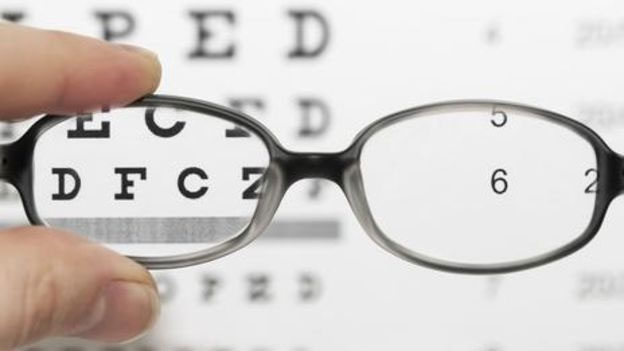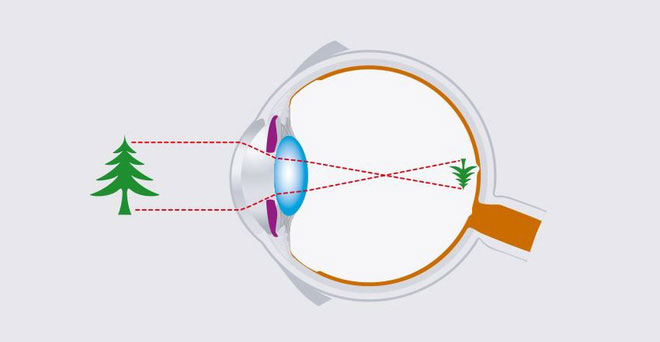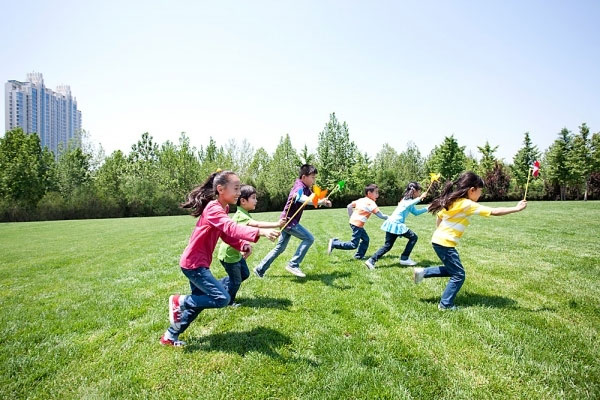To reduce the risk of myopia, let your children play outside for at least 1 hour a day
In 2010, 28% of the world's population was nearsighted. That number will increase to 40% by 2030, according to a new World Health Organization report. Most affected are East Asia, Southeast Asia and North America.
According to the researchers, responsible for this rate of visual impairment is the urban lifestyle surrounded by electronics.

Myopia often occurs and develops in young children when the eyes are in the developmental stage. By adulthood, myopia will stop developing. However, if your vision declines too quickly, you may have severe nearsightedness before it stops growing. Even when nearsightedness stops growing, you are at a higher risk for other eye conditions such as cataracts, macular degeneration, glaucoma, and retinal detachment. These diseases can cause permanent blindness.

Genetics may be part of the reason for myopia. And environmental factors also contribute significantly to these eye problems, especially when you are young.
Studies have shown that children who spend a lot of time in activities that require vision, such as playing computer games, using computers, reading books, doing homework . are likely to be nearsighted. high. Because the child's eyes will naturally adapt physically to help look closer and bypass vision skills.

According to Ian Morgan, a professor of biomedical and biochemical sciences at the Australian National University, children who receive early education, and who are in a competitive educational environment, are at risk of early myopia and progression when young.
It is not that the distance from the TV or iPad to the eye is the main problem, it is important that the child's eyes need to rest.
Vision of children living in cities tends to be lower than that of children in rural areas. This may mean younger children in the city are less likely to go out and the natural light in apartments is less due to tall buildings blocking the Sun.

According to research, to limit nearsighted children need to be outdoors at least one hour a day. The ideal time is noon because the sun can increase the level of nerve dopamine in the brain, which inhibits the development of the eye.
In areas with the fastest increase in myopia in the world, parents are encouraged to increase their time outdoors after long hours of eye contact.
According to a study, nearsightedness is the cause of the world's labor productivity decreased by 244 billion USD annually. In the next decade, this number will rise sharply.
- Does using induction hob affect health?
- BMI calculation to assess whether the body is obese or undernourished
- Water bottles are safe for your health? Glass bottles, plastic bottles or metal bottles?
You should read it
- How to prevent diseases for children when the weather is seasonal
- What is the RSV virus?
- Download and experience the free blockbuster Sky: Children of the Light
- 12 simple tips to be a good father
- How to prevent inappropriate videos for children on YouTube
- 10 ways to protect iPhone / iPad from the curiosity of children
- 11 conundrums of children and this is the answer that every parent needs at times!
- 10 common diseases in children in the fall, symptoms and prevention
May be interested
- Eat nuts, fish daily cut asthma, the risk of rhinitis in children
 you may need to include nuts, butter, and fish in your child's diet every day because the amount of unsaturated fatty acids in your baby's blood is associated with a lower risk of asthma or high fever in age 16, suggest in a recent study showed.
you may need to include nuts, butter, and fish in your child's diet every day because the amount of unsaturated fatty acids in your baby's blood is associated with a lower risk of asthma or high fever in age 16, suggest in a recent study showed. - Psychosis in children increases the risk of addiction later
 a new study has found that mental disorders such as adhd in children can increase their risk of addiction after adulthood.
a new study has found that mental disorders such as adhd in children can increase their risk of addiction after adulthood. - Fun Creative Activities for Kids When They Are Bored
 this article will suggest age-appropriate activities to help keep your child entertained and focused. these activities can reduce boredom and help your child explore his or her creativity.
this article will suggest age-appropriate activities to help keep your child entertained and focused. these activities can reduce boredom and help your child explore his or her creativity. - How to Convert Time from 24-Hour to 12-Hour
 if you're confused when you see a clock displaying the time in a format like 14:24, you're probably not familiar with 24-hour time. this convention is often used in the us military, in europe and many other parts of the world. fortunately, converting time from 24-hour to 12-hour (or standard) and vice versa is very simple. you just need to convert the hours, and keep the minutes the same.
if you're confused when you see a clock displaying the time in a format like 14:24, you're probably not familiar with 24-hour time. this convention is often used in the us military, in europe and many other parts of the world. fortunately, converting time from 24-hour to 12-hour (or standard) and vice versa is very simple. you just need to convert the hours, and keep the minutes the same. - Download and experience the free blockbuster Sky: Children of the Light
 sky: children of the light is an adventure, multi-player puzzle game, first announced during apple's iphone x launch event in 2017.
sky: children of the light is an adventure, multi-player puzzle game, first announced during apple's iphone x launch event in 2017. - 12 simple tips to be a good father
 after losing my father when i was only 12 years old, i was always grateful to have spent these moments with my father and hoped the following tips would help other fathers to love and play with their children. more. invite you to consult!
after losing my father when i was only 12 years old, i was always grateful to have spent these moments with my father and hoped the following tips would help other fathers to love and play with their children. more. invite you to consult! - Children with sinusitis, pneumonia are at risk of asthma after adulthood
 parents be careful! children with respiratory infections, especially colds and sinusitis from 6 months to 5 years, are at greater risk of asthma and worsening lung function in later life.
parents be careful! children with respiratory infections, especially colds and sinusitis from 6 months to 5 years, are at greater risk of asthma and worsening lung function in later life. - 8 great children's channels on YouTube help children play and sing, learn English happily
 here are the top 8 useful youtube channels to help children easily learn english while still being able to play happily.
here are the top 8 useful youtube channels to help children easily learn english while still being able to play happily. - 11 extremely useful tips that glasses wearers must know
 if life is always associated with glasses, then you must know these 11 tips to apply when needed.
if life is always associated with glasses, then you must know these 11 tips to apply when needed. - The suffering that only those who have access to understand, now have a way to solve it thoroughly
 glass keeps getting blurry when you eat hot food? whoever wears glasses, immediately learn this tip! extremely miraculous!
glass keeps getting blurry when you eat hot food? whoever wears glasses, immediately learn this tip! extremely miraculous!










 Does using induction hob affect health?
Does using induction hob affect health? What bad thing would happen to Earth if the sea was no longer salty?
What bad thing would happen to Earth if the sea was no longer salty? 10 species of land predatory fish in the natural world
10 species of land predatory fish in the natural world Water bottles are safe for your health? Glass bottles, plastic bottles or metal bottles?
Water bottles are safe for your health? Glass bottles, plastic bottles or metal bottles? Why are there no three-legged creatures on Earth?
Why are there no three-legged creatures on Earth? BMI calculation to assess whether the body is obese or undernourished
BMI calculation to assess whether the body is obese or undernourished